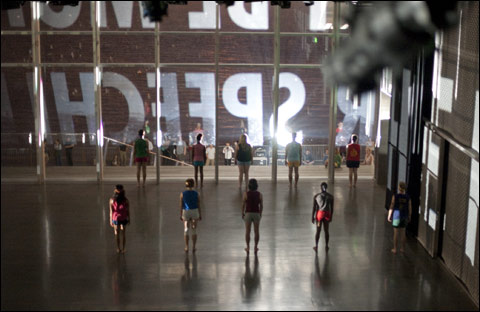
I SAY THE WORD: Gutierrez’s work seemed like half a dance — it was Holzer’s show. |
Summer Stages Dance and the Institute of Contemporary Art's second "Co-Lab" production a week ago Wednesday was less like a team effort than a game with a stacked deck. Pairing superstar visual artist Jenny Holzer with offbeat New York choreographer Miguel Gutierrez may have seemed a great idea, but what happened on site was pretty much Holzer's show.
In a pre-performance talk with Summer Stages co-director Richard Colton, Holzer and Gutierrez were disarmingly frank about their unlikely partnership. They'd met for the first time when Holzer arrived in Boston two days before the performance, though they'd talked on the phone for some months. They seemed comfortable with each other, if not bosom buddies. Holzer supplied Gutierrez with an inspirational poem by her current textmaster, the Polish poet Wislawa Szymborska, which Colton got Gutierrez to read. Something about how there's no rehearsal for life, you just do the performance. You could see why he'd take it to heart. He said he made I Say the Word — title also supplied by Holzer — in two weeks. No doubt he could have used more time.
But the two artists had a lot in common. Both spoke about wanting their work to address the world's big questions. Holzer dispenses provocative quotations for passers-by to stumble upon and ponder. Gutierrez's dancers behave like ordinary people pretending they're not under stress. Both artists admitted to having taken plenty of wrong turns and detours in their own lives. And both offered practiced public personas: Holzer dry, plainspoken, unflappable, smart; Gutierrez smart, political, onto himself and joking about it.
I was thrilled to get the chance to see a work by Gutierrez, who's one of a burgeoning generation of new choreographers whom few presenters have the courage to bring to Boston. In the event, however, I felt I'd seen only about half a dance, and I still don't know what makes Gutierrez and the Powerful People tick.
He began I Say the Word standing in front of a microphone in a spotlight. "I was destined to fail," he announced. His whole torso from hips to sternum was shuddering as he continued to talk about making art and trying not to end up "frozen, forgotten, and famous."
He was joined by nine other dancers, who all clumped together and shuddered until they guffawed. They were dressed alike in gender-diffusing shorts, headbands, and tank tops with different slogans printed on them. The Globe's Thea Singer, who was sitting closer than I, reported that they all wore moustaches.
After a long series of slow, twisting floor rolls, with one man silently exhorting the crowd, they began to walk through the space. They seemed to be using some old '70s-style improvisation gambits, like "Walk until you meet another person, then change direction." Very simple, and interesting because of the dancers' different body types and their many lumpen ways of moving.